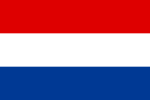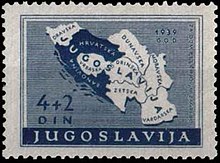Croatian bank
| Flag (unofficial) |
coat of arms |
|---|---|
 Variant 1 Variant 2 
|
 Large coat of arms. Small coat of arms  |
| ( Details ) | ( Details ) |
| Basic data | |
| Capital : | Zagreb |
| Area : | 66,393 km² |
| Residents : | 4,403,199 |
| Population density : | 66.32 inhabitants per km² |
| Official languages : | Croatian |
| GDP : | |
| Form of government : | Semi-autonomous Banschaft in the Kingdom of Yugoslavia |
| Ban : |
Ivan Šubašić (1939–1941) |
| Founding: | August 26, 1939 |
| map | |

|
|
The partially autonomous Banschaft Croatia ( Serbo-Croatian Бановина Хрватска / Banovina Hrvatska ) in the Kingdom of Yugoslavia was established on August 26, 1939 with the Serbian-Croatian settlement through the Sporazum Cvetković - Maček . The aim was to defuse the Croatian-Serbian conflict and thus to bring about the political stabilization of the Kingdom of Yugoslavia.
The Croatian Banschaft was formed from the predominantly Croatian- inhabited areas of various Royal Yugoslavian Banships, including the Croatian majority areas in Bosnia and Herzegovina . It existed until the Kingdom of Yugoslavia was broken up and the Independent State of Croatia was founded on April 10, 1941.
history
The Croatians were granted their own administrative unit by law, which meant that the idea of equalization in Yugoslavia should be successfully implemented. This included, among other things, providing the Croatian bank with extensive rights of self-determination as well as domestic political and economic competencies. Yugoslavia now consisted of seven Yugoslav and one Croatian banks.
In 1941 the Royal Yugoslav Army surrendered after the invasion of German, Italian and Hungarian troops and the Kingdom of Yugoslavia was smashed. This ended the Banschaft Croatia, on whose territory the Independent State of Croatia was founded as a vassal state of the Axis powers on April 10th .
geography
The area of the Croatian Banschaft was 66,393 km² and comprised that which had existed until then
as well as the following districts ( kotari ) of other banks:
- Dubrovnik ( Zeta-Banschaft )
- Šid ( Danube Bank )
- Ilok (Danube Bank)
- Brčko ( Drina Banschaft )
- Gradačac ( Vrbas Banschaft )
- Derventa (Vrbas Banschaft)
- Travnik (Drina Banschaft)
- Fojnica (Drina Banschaft).
The capital of the Croatian Banschaft was Zagreb .
population
The Croatian Banschaft had 4,403,199 inhabitants, including:
- 3,061,680 Croatians
- 847,005 Serbs
- 174,150 Bosniaks
- 96,023 Germans
- 62,647 Magyars
- 40,939 Czechs
- 40,524 Slovenes
- 13,189 Slovaks
- 7,468 Ukrainians
- 6,867 Italians
- 5,498 Russians
- 5,414 Poles
- 41,956 others.
Outside the Croatian Banschaft 421,198 Croats remained in the Yugoslav regions of Bosnia and Herzegovina (205,987), Vojvodina (121,741), Syrmia (31,227), Bay of Kotor (14,172), Slovenia (19,354), Serbia and Montenegro (28,717) and the then still Istria and Rijeka belonging to Italy .
Cities
The towns of the Croatian Banschaft with the most inhabitants were Zagreb (185,581), Split (43,711), Osijek (40,337), Šibenik (37,271), Karlovac (21,210), Mostar (20,295), Dubrovnik (16,147), Sušak (16,111), Varaždin (14,612), Brod (13,776), Vinkovci (13,267), Sisak (10,915), Vukovar (10,862), Virovitica (10,652), Bjelovar (10,252) and Koprivnica (9,472).
Symbols
flag
Before the establishment of the Croatian Bank, the use of the Croatian red-white-blue tricolor was forbidden. After the establishment of the Croatian Ban, no official flag was set. On the private and state side, however, the use of a horizontally divided red-white-blue flag with the coat of arms of Croatia in the middle of the white stripe (beginning with the first red field) became common law. This flag was often used without a coat of arms.
coat of arms

In contrast to the flag, the coat of arms of the Croatian Banschaft was officially established with the decree of the Banschaftlichen Cabinet on September 10, 1940. The decree prescribed the practical use of a large and a small coat of arms for all government agencies of the Croatian Banquet and was provided with the drawings of the two coats of arms. The aim of the decree was to standardize, after different versions were used in the administration in the first months of the bank.
The large coat of arms of the Croatian Banschaft showed the Serbian or Royal Yugoslav double-headed eagle with red beaks, tongues and fangs. Crowned with the Yugoslav royal crown and covered with a golden-framed heart shield with the coat of arms of Croatia (starting with a first red field). It was used on the oval white nameplates at the entrances to buildings with public offices (e.g. ministries, notaries).
The small coat of arms of the Banschaft Croatia showed the golden-framed heart shield of the large coat of arms, crowned with the Yugoslav royal crown. It was used e.g. B. for official seals, stamps and postage stamps.
politics
State order
The creation of the Banschaft Croatia did not result in the formation of a federation , as was sometimes requested by the Croatian side. This process did not result in a restructuring of the state or an amendment to the constitution, but held out the prospect of a final settlement for later. Rather, the central state (Kingdom of Yugoslavia) delegated competences and responsibilities to a sub-state (Banschaft Croatia).
State Parliament
The bond with the state as a whole was emphasized by the entry of Vladko Maček as deputy prime minister into the royal Yugoslav cabinet. The Croatians Juraj Šutej joined the state cabinet as finance minister, Ivan Andres as trade minister and Josip Torbar as postal minister. In this way “the participation and cooperation of the Croatians in the life of the state [Kingdom of Yugoslavia] and thus the public interests” should be ensured.
Self-management
Within its borders, the Croatian Banschaft was given responsibility for agriculture, trade and industry, forest and mining administration, public works, social policy, public health care, physical training, justice, teaching, internal administration and financial independence. The Yugoslav central government was still responsible for the military, transport, international trade and foreign policy.
Banal Government (1940)
| Area | Office | Official | fitness |
|---|---|---|---|
| Ban of Croatia ( Ban Hrvatske ) |
Dr. Ivan Šubašić | ||
| Vice-Ban ( Podban ) |
Dr. Ivo Krbek | Law professor ( Profesor prava ) |
|
| Presidential Office ( Predsjednički ured ) |
ladder | Frane Frol | Banking advisor ( Banski savjetnik ) |
| Cabinet of the Ban ( Kabinet Bana ) |
Head of Cabinet ( Šef kabineta ) |
Vladimir Šipuš | Banking advisor ( Banski savjetnik ) |
| Ministry of Internal Affairs ( Odjel za unutarnje poslove ) |
Minister ( Odjelni predstojnik ) |
Bogdan Bojkić | Banking advisor ( Banski savjetnik ) |
| Ministry of Education ( Odjel za prosvjetu ) |
Minister ( Odjelni predstojnik ) |
Prof. Izidor Škorjač | Banking advisor ( Banski savjetnik ) |
| Ministry of Justice (Odjel za pravosuđe) |
Minister ( Odjelni predstojnik ) |
Dr. Franjo Žilić | Judge ( Sudac Stola sedmorice ) |
| Ministry of Agriculture ( Odjel za seljačko gospodarstvo ) |
Minister ( Odjelni predstojnik ) |
Slavko Kolar | Banking advisor ( Banski savjetnik ) |
| Independent Veterinary Department ( Samostalni odsjek za veterinarstvo ) |
Head of Department ( Šef odsjeka ) |
Dr. Šime Debelić | Full University Professor ( Redoviti sveučilišni profesor ) |
| Ministry of Forestry ( Odjel za šumarstvo ) |
Minister ( Odjelni predstojnik ) |
Ing. Ivica Frković | Banking advisor ( Banski savjetnik ) |
| Ministry of Mining (Odjel za rudarstvo) |
Minister ( Odjelni predstojnik ) |
Ing. Nikola Belančić | Banking advisor ( Banski savjetnik ) |
| Ministry of Crafts, Industry and Trade ( Odjel za obrt, industriju i trgovinu ) |
Minister ( Odjelni predstojnik ) |
Dr. Mirko Lamer | Excellent professor of the Higher Commercial School ( Izvanred. Prof. Visoke ekon. Komerc. Škole ) |
| Ministry of Technical Affairs ( Odjel za tehničke radove ) |
Minister ( Odjelni predstojnik ) |
Ing. Zvonimir Pavešić | Banking advisor ( Banski savjetnik ) |
| Ministry of Social Policy ( Odjel za socijalnu politiku ) |
Minister ( Odjelni predstojnik ) |
Dr. Josip Rasuhin | Banking advisor ( Banski savjetnik ) |
| Ministry of National Health ( Odjel za narodno zdravlje ) |
Minister ( Odjelni predstojnik ) |
Dr. Milutin Kosanović | Banking advisor ( Banski savjetnik ) |
| Ministry of Financial Affairs ( Odjel za financijalne poslove ) |
Minister ( Odjelni predstojnik ) |
Dr. Vladimir Franolić | Excellent university professor ( Izvanredni sveučilišni profesor ) |
| Branch office of the banal government in Split ( Izpostava banske vlasti u Splitu ) |
Commissioner of the branch office of the banal government ( Povjerenik ispostave banske vlasti ) |
Mate Bulic | Banking advisor ( Banski savjetnik ) |
| Deputy Commissioner of the Banal Government Branch Office ( Zamjen. Povjerenika ispostave banske vlasti ) |
Ante Jauk | Consultants ( Odjelni savjetnik ) |
Culture
The first Croatian encyclopedia was realized with state support from the Croatian Banschaft . The first volume of this culturally very important project was published in February 1941.
meaning
For the Kingdom of Yugoslavia, the formation of the Banschaft Croatia meant a departure from the state centralism that had prevailed until then and a change in the previous state order. In contrast to the existing and remaining banks, the Croatian bank was formed according to the ethnic principle, i.e. H. the majority of Croatian populated areas were united in a Banschaft. This also de facto ended the ideology of national and state unity in the Kingdom of Yugoslavia and laid the foundation for a future federal state order.
The Serbian-Croatian settlement did not have the desired effect for either party. For many Croatians the autonomy did not go far enough; in particular, they accused Vladko Maček of having betrayed Croatia's national cause by surrendering Bosnia, which for the most part did not belong to the Croatian Banschaft. The centralist Serbs also accused the government of betraying their national interests.
literature
- Stjepan Šlajbek: Banovina Hrvatska: Pravno povijesni pristup . 3. Edition. Vlastita naklada, Kutina 1997.
- Godišnjak Banske vlasti Banovine Hrvatske: 1939 - 26. VIII. - 1940: I. [Yearbook of the Banish Government of the Banish of Croatia] . Zaklade tiskare narodnih novina, Zagreb 1940 ( http://www.sumari.hr/biblio/pdf/10277.pdf , some pages [PDF]).
- Mirko Glojnarić: Borba Hrvata: Kronika dvaju desetljeća političke povijesti (1919–1939) [The Struggle of the Croats: Chronicle of Two Decades of Political History (1919–1939)] . 2nd Edition. Naklada Antuna Velzeka, Zagreb 1940.
Web links
Individual evidence
- ↑ a b c Karta Banovine Hrvatske sa statističkim podacima (map of the Croatian bank with statistical data). Naklada Kluba ABC i Seljačke Sloge, Zagreb 1939.
- ↑ Article I. of the Regulation on the Banschaft Croatia ( Uredba o banovini Hrvatskoj ). In: Mirko Glojnarić: Borba Hrvata. Kronika dvaju desetljeća političke povijesti (1919–1939). 2nd Edition. Naklada Antuna Velzeka, Zagreb 1940, p. 323.
- ↑ Fig. In: Jelena Borošak-Marijanović: Zastave kroz stoljeća. Zbirka zastava i zastavnih vrpca Hrvatskoga povijesnog muzeja (= Hrvatski Povijesni Muzej. Catalog muzejskih zbirki. Vol. 27). Hrvatski povijesni muzej, Zagreb 1996, ISBN 953-6046-07-5 .
- ↑ Okružnica Kabineta bana Banovine Hrvatske , No. 64178-1940 of September 10, 1940. In: Rhea Ivanuš, Lucija Benyovsky and others: Stoljeće promjena. Hrvatski povijesni muzej, Zagreb 2000, ISBN 953-6046-21-0 .
- ^ Mirko Glojnarić: Borba Hrvata. Kronika dvaju desetljeća političke povijesti (1919–1939). 2nd Edition. Naklada Antuna Velzeka, Zagreb 1940, pp. 322-344.
- ↑ Introduction to the regulation on the Banschaft Croatia ( Uredba o banovini Hrvatskoj ). In: Mirko Glojnarić: Borba Hrvata. Kronika dvaju desetljeća političke povijesti (1919–1939). 2nd Edition. Naklada Antuna Velzeka, Zagreb 1940, p. 323.
- ↑ Article II of the Regulation on the Banschaft Croatia ( Uredba o banovini Hrvatskoj ). In: Mirko Glojnarić: Borba Hrvata. Kronika dvaju desetljeća političke povijesti (1919–1939). 2nd Edition. Naklada Antuna Velzeka, Zagreb 1940, p. 323.
- ^ Ljubodrag Dimić: Serbia and Yugoslavia 1918–1941 . In: Walter Lukan: Serbia and Montenegro. Space and Population - History - Language and Literature - Culture - Politics - Society - Economy - Law (= Österreichische Osthefte. Vol. 47, No. 1/4, 2005 = Osthefte. Special Vol . 18). Lit-Verlag, Vienna et al. 2006, ISBN 3-8258-9539-4 , pp. 231–265, here p. 263.





